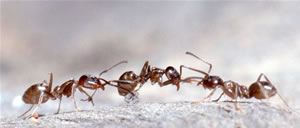Study Links Success of Invasive Argentine Ants to Diet Shifts
December 18, 2007
By Kim McDonald

Argentine Ants Fighting
Marc Dantzker
The ability of Argentine ants to change from carnivorous insect eaters to plant sap-loving creatures has helped these invasive social insects rapidly spread throughout coastal California, according to a new study, displacing many native insects and creating ant infestations familiar to most coastal residents.
Biologists at the University of California, San Diego and the University of Illinois at Urbana discovered the opportunistic, changing dietary preferences of California's Argentine ants-the first time researchers have documented what these invasive ants actually eat-by studying a population of ants for eight years in the foothills southeast of San Diego. An advance copy of their paper is being published online this week in the journal Proceedings of the National Academy of Sciences.
"Despite the fact that these species are known to cause ecological problems in many countries, scientists really didn't know what they eat," said David Holway, an associate professor of biological sciences at UC San Diego who headed the study conducted in California and Argentina.
Holway, Edward LeBrun of UCSD, and Chadwick Tillberg and Andrew Suarez of Illinois discovered that when Argentine ants first move into an area they become fierce predators of native insects, feeding on the blood of native ants and other insects. But as the ants eliminate their competitors-and their main source of food-over time, they switch from a carnivorous, protein-rich diet to a largely carbohydrate, sugar-water diet as they begin feeding on the honeydew nectar from aphids and scales.
Insights into the ant's food sources were obtained through the use of nitrogen isotopes, which provided information about the relative amounts of protein and carbohydrate in their diets.
"Honeydew nectar is essentially digested plant sap excreted by aphids and scales," said Holway. "If you've ever parked your car under a tree and found your windshield covered with sticky stuff, that's honeydew from aphids or scales."
The change in the ants' diet not only allows them to survive as they eliminate their food of native insects. But because much more plant material than insect protein is available in irrigated residential communities, this switch to carbohydrates allows the ants to effectively expand their populations, the scientists say.

Argentine Ants Tend Scale Insects
Marc Dantzker
"By virtue of this great dietary flexibility, Argentine ants are able to consume a variety of sources of food and it's this ability to consume carbohydrates that contributes to their success," said Holway.
Holway and Suarez found that another reason for the Argentine ant's success was the lack of genetic diversity among ant colonies up and down the California coast. That study, published in 2000 in the Proceedings of the National Academy of Science, was conducted when Suarez, now an assistant professor of entomology and animal biology at Illinois, was a UCSD graduate student.
The scientists concluded that this reduced genetic variation had allowed a giant "supercolony" of closely related ants to grow unchecked from San Diego to Ukiah, 100 miles north of San Francisco. In Argentina, by contrast, fighting among the more genetically dissimilar, territorial ants managed to keep these insects in check and in smaller, much more sharply defined colonies than those in California.
The tiny dark-brown and black Argentine ants, which are about two millimeters in length, are thought to have entered the United States aboard ships carrying coffee or sugar from Argentina during the 1890s, then expanded throughout California and the southern parts of the United States. In the Southeast and much of the South, their proliferation is now limited to some extent by the introduction of fire ants.
But in California, where those competitors are largely absent, the ants thrive in the mild coastal regions, killing and displacing native ants, many of which are 10 times larger in size. Their growth has not only been a problem for native ant species, but for species that feed on the larger native ants. One such creature is the coastal horned lizard, which has declined by at least 50 percent in recent years.
Holway said their previous research had shown that the Argentine ants tended to invade semi-arid regions of Southern California where new residential developments and backyard gardens have sprouted, requiring increased irrigation.
"We now know why," he said. "Our latest study demonstrates that plant-based resources such as honeydew and nectar are important to the expansion of Argentine ant colonies."
It also offers a lesson for California residents wanting to control ant infestations in their homes. "If you cut down on watering to limit plant growth, Argentine ant numbers should decline," Holway said.
